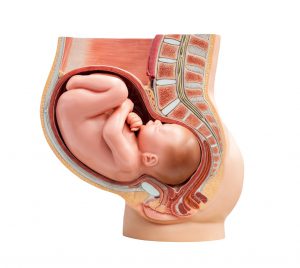A woman’s body goes through many changes during pregnancy and childbirth. Some of these changes directly affect a region of her body called the vulva. The vulva are a woman’s external genitalia and include the vestibule, labia, and clitoris. The labia surround the vestibule, or opening of the vagina, and consist of two sets of skin folds called the labia majora and labia minora. Labia majora is a Latin term meaning large lips, and labia minora is Latin for small lips. These terms are meant to describe the general appearance of these parts of a woman’s body. A woman can easily distinguish these parts from one another. The labia majora are larger, have pubic hair and sebaceous and sweat glands, and are found outside of the minora. The labia minora are pink due to the presence of numerous blood vessels. These blood vessels swell when stimulated, such as during sex. This general appearance of a woman’s labia will often change as she progresses through pregnancy and childbirth.
As pregnancy progresses, blood flow to the labia increases, and hormonal changes occur. These changes begin as early as one month into pregnancy and cause the labia to turn slightly blue in color. In addition to this color change, the labia will swell or increase in size. Although this swelling is usually mild, it can be more prominent in some women, especially first-time moms. Swelling of the labia can also increase after prolonged pushing during childbirth, as we describe here. Even with mild swelling, women often describe a heavy or full feeling in the vaginal region. This heaviness increases as the pregnancy progresses and may be further affected by pressure from the growing uterus. Ice packs can help reduce labial discomfort and swelling during pregnancy or after birth. The size and color of the labia usually return to normal without medical help within the first few months after delivery.
The increased blood flow, hormones, and growing uterus may also affect the appearance of labial veins in a small number of women. The uterus and developing baby place increased pressure on veins in the pelvis, and hormones can cause the veins to dilate and widen, forming varicose veins. Labial varicose veins are visible due to the extra dilation and swelling. Although pregnant women often develop varicose veins in their legs, fewer than 5% experience varicose veins in their labia. The chances may be increased if a woman is older, obese, smokes, or has a family history of varicose veins. Although labial varicose veins can cause discomfort during pregnancy, they generally disappear a few months after the baby is born.
Another labial change that may be encountered during childbirth, as the baby is pushed out, is stretching, which can cause the labia minora to elongate or even tear. Although a woman may not realize that her labia are torn, she may see bleeding and feel sore, especially when urinating. These symptoms can be discussed with her physician. The American Congress of Obstetricians and Gynecologists estimates that about 50-80% of women who have vaginal deliveries will experience some degree of tearing in their vaginal region. Labial tears are usually mild and are easy to fix with stitches, but even if they go undetected, they will usually heal on their own. Rarely, a woman may have persistent problems with labial enlargement or scarring lasting more than six months after delivery. Although this is uncommon, the increased size of the labia may cause discomfort, including during exercise or sex. The stretched labia can also snag on undergarments or cause additional pain due to twisting or tugging of the skin. Labiaplasty can be performed to reduce the size of the labia minora, so they don’t hang below the labia majora, but is usually only recommended in cases of extreme discomfort. A woman should speak with her gynecologist about available options for her specific situation.
Labial changes, primarily affecting color and swelling, are common during pregnancy and childbirth. Fortunately, the majority of labial issues resolve a few months after delivery without the need for medical intervention. If a woman is experiencing discomfort in the vaginal area, including the labia, she should consult her physician for advice.

